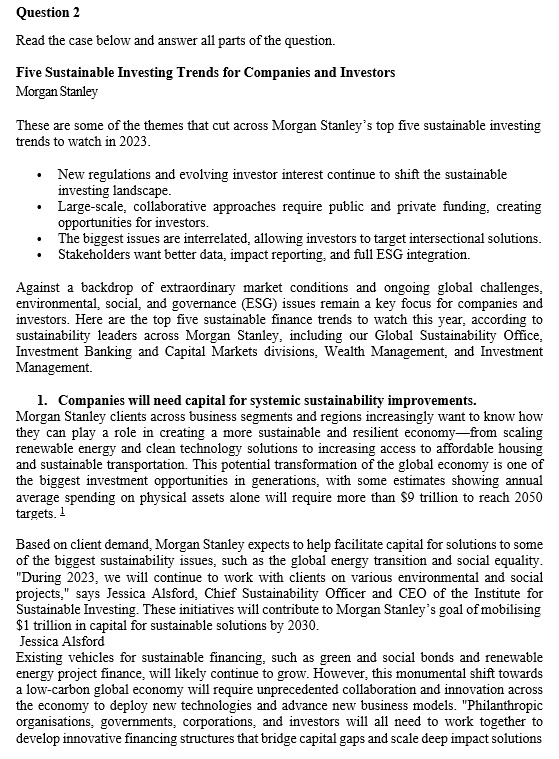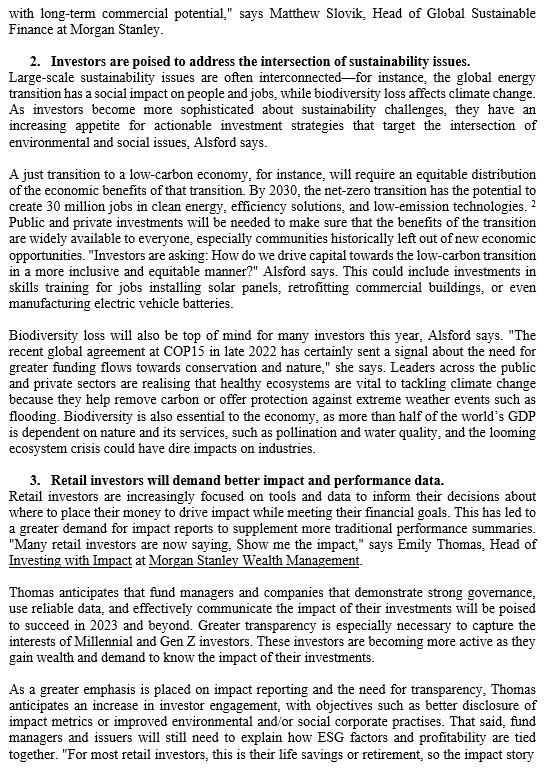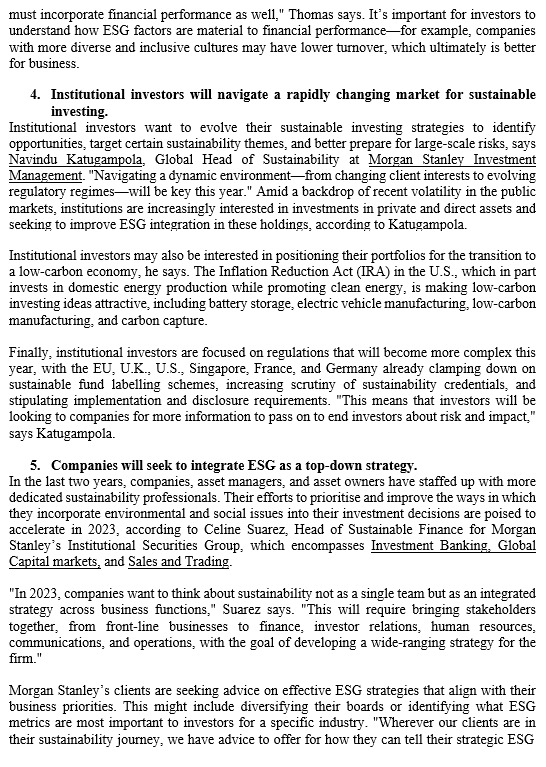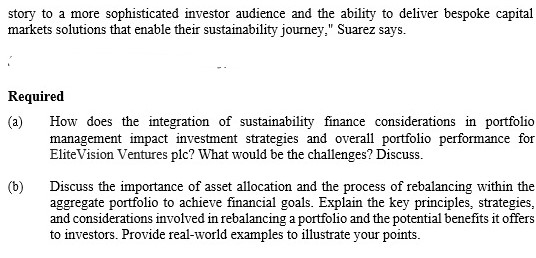Answered step by step
Verified Expert Solution
Question
1 Approved Answer
Question 2 Read the case below and answer all parts of the question. Five Sustainable Investing Trends for Companies and Investors Morgan Stanley These are



 Question 2 Read the case below and answer all parts of the question. Five Sustainable Investing Trends for Companies and Investors Morgan Stanley These are some of the themes that cut across Morgan Stanley's top five sustainable investing trends to watch in 2023 . - New regulations and evolving investor interest continue to shift the sustainable investing landscape. - Large-scale, collaborative approaches require public and private funding, creating opportunities for investors. - The biggest issues are interrelated, allowing investors to target intersectional solutions. - Stakeholders want better data, impact reporting, and full ESG integration. Against a backdrop of extraordinary market conditions and ongoing global challenges, environmental, social, and governance (ESG) issues remain a key focus for companies and investors. Here are the top five sustainable finance trends to watch this year, according to sustainability leaders across Morgan Stanley, including our Global Sustainability Office, Investment Banking and Capital Markets divisions, Wealth Management, and Investment Management. 1. Companies will need capital for systemic sustainability improvements. Morgan Stanley clients across business segments and regions increasingly want to know how they can play a role in creating a more sustainable and resilient economy-from scaling renewable energy and clean technology solutions to increasing access to affordable housing and sustainable transportation. This potential transformation of the global economy is one of the biggest investment opportunities in generations, with some estimates showing annual average spending on physical assets alone will require more than $9 trillion to reach 2050 targets. 1 Based on client demand, Morgan Stanley expects to help facilitate capital for solutions to some of the biggest sustainability issues, such as the global energy transition and social equality. "During 2023, we will continue to work with clients on various environmental and social projects," says Jessica Alsford, Chief Sustainability Officer and CEO of the Institute for Sustainable Investing. These initiatives will contribute to Morgan Stanley's goal of mobilising $1 trillion in capital for sustainable solutions by 2030 . Jessica Alsford Existing vehicles for sustainable financing, such as green and social bonds and renewable energy project finance, will likely continue to grow. However, this monumental shift towards a low-carbon global economy will require unprecedented collaboration and innovation across the economy to deploy new technologies and advance new business models. "Philanthropic organisations, governments, corporations, and investors will all need to work together to develop innovative financing structures that bridge capital gaps and scale deep impact solutions with long-term commercial potential," says Matthew Slovik, Head of Global Sustainable Finance at Morgan Stanley. 2. Investors are poised to address the intersection of sustainability issues. Large-scale sustainability issues are often interconnected-for instance, the global energy transition has a social impact on people and jobs, while biodiversity loss affects climate change. As investors become more sophisticated about sustainability challenges, they have an increasing appetite for actionable investment strategies that target the intersection of environmental and social issues, Alsford says. A just transition to a low-carbon economy, for instance, will require an equitable distribution of the economic benefits of that transition. By 2030, the net-zero transition has the potential to create 30 million jobs in clean energy, efficiency solutions, and low-emission technologies. 2 Public and private investments will be needed to make sure that the benefits of the transition are widely available to everyone, especially communities historically left out of new economic opportunities. "Investors are asking: How do we drive capital towards the low-carbon transition in a more inclusive and equitable manner?" Alsford says. This could include investments in skills training for jobs installing solar panels, retrofitting commercial buildings, or even manufacturing electric vehicle batteries. Biodiversity loss will also be top of mind for many investors this year, Alsford says. "The recent global agreement at COP15 in late 2022 has certainly sent a signal about the need for greater funding flows towards conservation and nature," she says. Leaders across the public and private sectors are realising that healthy ecosystems are vital to tackling climate change because they help remove carbon or offer protection against extreme weather events such as flooding. Biodiversity is also essential to the economy, as more than half of the world's GDP is dependent on nature and its services, such as pollination and water quality, and the looming ecosystem crisis could have dire impacts on industries. 3. Retail investors will demand better impact and performance data. Retail investors are increasingly focused on tools and data to inform their decisions about where to place their money to drive impact while meeting their financial goals. This has led to a greater demand for impact reports to supplement more traditional performance summaries. "Many retail investors are now saying, Show me the impact," says Emily Thomas, Head of Investing with Impact at Morgan Stanley Wealth Management. Thomas anticipates that fund managers and companies that demonstrate strong governance, use reliable data, and effectively communicate the impact of their investments will be poised to succeed in 2023 and beyond. Greater transparency is especially necessary to capture the interests of Millennial and Gen Z investors. These investors are becoming more active as they gain wealth and demand to know the impact of their investments. As a greater emphasis is placed on impact reporting and the need for transparency, Thomas anticipates an increase in investor engagement, with objectives such as better disclosure of impact metrics or improved environmental and/or social corporate practises. That said, fund managers and issuers will still need to explain how ESG factors and profitability are tied together. "For most retail investors, this is their life savings or retirement, so the impact story must incorporate financial performance as well," Thomas says. It's important for investors to understand how ESG factors are material to financial performance-for example, companies with more diverse and inclusive cultures may have lower turnover, which ultimately is better for business. 4. Institutional investors will navigate a rapidly changing market for sustainable investing. Institutional investors want to evolve their sustainable investing strategies to identify opportunities, target certain sustainability themes, and better prepare for large-scale risks, says Navindu Katugampola, Global Head of Sustainability at Morgan Stanley Investment Management. "Navigating a dynamic environment-from changing client interests to evolving regulatory regimes-will be key this year." Amid a backdrop of recent volatility in the public markets, institutions are increasingly interested in investments in private and direct assets and seeking to improve ESG integration in these holdings, according to Katugampola. Institutional investors may also be interested in positioning their portfolios for the transition to a low-carbon economy, he says. The Inflation Reduction Act (IRA) in the U.S., which in part invests in domestic energy production while promoting clean energy, is making low-carbon investing ideas attractive, including battery storage, electric vehicle manufacturing, low-carbon manufacturing, and carbon capture. Finally, institutional investors are focused on regulations that will become more complex this year, with the EU, U.K., U.S., Singapore, France, and Germany already clamping down on sustainable fund labelling schemes, increasing scrutiny of sustainability credentials, and stipulating implementation and disclosure requirements. "This means that investors will be looking to companies for more information to pass on to end investors about risk and impact," says Katugampola. 5. Companies will seek to integrate ESG as a top-down strategy. In the last two years, companies, asset managers, and asset owners have staffed up with more dedicated sustainability professionals. Their efforts to prioritise and improve the ways in which they incorporate environmental and social issues into their investment decisions are poised to accelerate in 2023, according to Celine Suarez, Head of Sustainable Finance for Morgan Stanley's Institutional Securities Group, which encompasses Investment Banking, Global Capitalmarkets,andSalesandTrading. "In 2023, companies want to think about sustainability not as a single team but as an integrated strategy across business functions," Suarez says. "This will require bringing stakeholders together, from front-line businesses to finance, investor relations, human resources, communications, and operations, with the goal of developing a wide-ranging strategy for the firm." Morgan Stanley's clients are seeking advice on effective ESG strategies that align with their business priorities. This might include diversifying their boards or identifying what ESG metrics are most important to investors for a specific industry. "Wherever our clients are in their sustainability journey, we have advice to offer for how they can tell their strategic ESG story to a more sophisticated investor audience and the ability to deliver bespoke capital markets solutions that enable their sustainability journey," Suarez says. Required (a) How does the integration of sustainability finance considerations in portfolio management impact investment strategies and overall portfolio performance for EliteVision Ventures plc? What would be the challenges? Discuss. (b) Discuss the importance of asset allocation and the process of rebalancing within the aggregate portfolio to achieve financial goals. Explain the key principles, strategies, and considerations involved in rebalancing a portfolio and the potential benefits it offers to investors. Provide real-world examples to illustrate your points
Question 2 Read the case below and answer all parts of the question. Five Sustainable Investing Trends for Companies and Investors Morgan Stanley These are some of the themes that cut across Morgan Stanley's top five sustainable investing trends to watch in 2023 . - New regulations and evolving investor interest continue to shift the sustainable investing landscape. - Large-scale, collaborative approaches require public and private funding, creating opportunities for investors. - The biggest issues are interrelated, allowing investors to target intersectional solutions. - Stakeholders want better data, impact reporting, and full ESG integration. Against a backdrop of extraordinary market conditions and ongoing global challenges, environmental, social, and governance (ESG) issues remain a key focus for companies and investors. Here are the top five sustainable finance trends to watch this year, according to sustainability leaders across Morgan Stanley, including our Global Sustainability Office, Investment Banking and Capital Markets divisions, Wealth Management, and Investment Management. 1. Companies will need capital for systemic sustainability improvements. Morgan Stanley clients across business segments and regions increasingly want to know how they can play a role in creating a more sustainable and resilient economy-from scaling renewable energy and clean technology solutions to increasing access to affordable housing and sustainable transportation. This potential transformation of the global economy is one of the biggest investment opportunities in generations, with some estimates showing annual average spending on physical assets alone will require more than $9 trillion to reach 2050 targets. 1 Based on client demand, Morgan Stanley expects to help facilitate capital for solutions to some of the biggest sustainability issues, such as the global energy transition and social equality. "During 2023, we will continue to work with clients on various environmental and social projects," says Jessica Alsford, Chief Sustainability Officer and CEO of the Institute for Sustainable Investing. These initiatives will contribute to Morgan Stanley's goal of mobilising $1 trillion in capital for sustainable solutions by 2030 . Jessica Alsford Existing vehicles for sustainable financing, such as green and social bonds and renewable energy project finance, will likely continue to grow. However, this monumental shift towards a low-carbon global economy will require unprecedented collaboration and innovation across the economy to deploy new technologies and advance new business models. "Philanthropic organisations, governments, corporations, and investors will all need to work together to develop innovative financing structures that bridge capital gaps and scale deep impact solutions with long-term commercial potential," says Matthew Slovik, Head of Global Sustainable Finance at Morgan Stanley. 2. Investors are poised to address the intersection of sustainability issues. Large-scale sustainability issues are often interconnected-for instance, the global energy transition has a social impact on people and jobs, while biodiversity loss affects climate change. As investors become more sophisticated about sustainability challenges, they have an increasing appetite for actionable investment strategies that target the intersection of environmental and social issues, Alsford says. A just transition to a low-carbon economy, for instance, will require an equitable distribution of the economic benefits of that transition. By 2030, the net-zero transition has the potential to create 30 million jobs in clean energy, efficiency solutions, and low-emission technologies. 2 Public and private investments will be needed to make sure that the benefits of the transition are widely available to everyone, especially communities historically left out of new economic opportunities. "Investors are asking: How do we drive capital towards the low-carbon transition in a more inclusive and equitable manner?" Alsford says. This could include investments in skills training for jobs installing solar panels, retrofitting commercial buildings, or even manufacturing electric vehicle batteries. Biodiversity loss will also be top of mind for many investors this year, Alsford says. "The recent global agreement at COP15 in late 2022 has certainly sent a signal about the need for greater funding flows towards conservation and nature," she says. Leaders across the public and private sectors are realising that healthy ecosystems are vital to tackling climate change because they help remove carbon or offer protection against extreme weather events such as flooding. Biodiversity is also essential to the economy, as more than half of the world's GDP is dependent on nature and its services, such as pollination and water quality, and the looming ecosystem crisis could have dire impacts on industries. 3. Retail investors will demand better impact and performance data. Retail investors are increasingly focused on tools and data to inform their decisions about where to place their money to drive impact while meeting their financial goals. This has led to a greater demand for impact reports to supplement more traditional performance summaries. "Many retail investors are now saying, Show me the impact," says Emily Thomas, Head of Investing with Impact at Morgan Stanley Wealth Management. Thomas anticipates that fund managers and companies that demonstrate strong governance, use reliable data, and effectively communicate the impact of their investments will be poised to succeed in 2023 and beyond. Greater transparency is especially necessary to capture the interests of Millennial and Gen Z investors. These investors are becoming more active as they gain wealth and demand to know the impact of their investments. As a greater emphasis is placed on impact reporting and the need for transparency, Thomas anticipates an increase in investor engagement, with objectives such as better disclosure of impact metrics or improved environmental and/or social corporate practises. That said, fund managers and issuers will still need to explain how ESG factors and profitability are tied together. "For most retail investors, this is their life savings or retirement, so the impact story must incorporate financial performance as well," Thomas says. It's important for investors to understand how ESG factors are material to financial performance-for example, companies with more diverse and inclusive cultures may have lower turnover, which ultimately is better for business. 4. Institutional investors will navigate a rapidly changing market for sustainable investing. Institutional investors want to evolve their sustainable investing strategies to identify opportunities, target certain sustainability themes, and better prepare for large-scale risks, says Navindu Katugampola, Global Head of Sustainability at Morgan Stanley Investment Management. "Navigating a dynamic environment-from changing client interests to evolving regulatory regimes-will be key this year." Amid a backdrop of recent volatility in the public markets, institutions are increasingly interested in investments in private and direct assets and seeking to improve ESG integration in these holdings, according to Katugampola. Institutional investors may also be interested in positioning their portfolios for the transition to a low-carbon economy, he says. The Inflation Reduction Act (IRA) in the U.S., which in part invests in domestic energy production while promoting clean energy, is making low-carbon investing ideas attractive, including battery storage, electric vehicle manufacturing, low-carbon manufacturing, and carbon capture. Finally, institutional investors are focused on regulations that will become more complex this year, with the EU, U.K., U.S., Singapore, France, and Germany already clamping down on sustainable fund labelling schemes, increasing scrutiny of sustainability credentials, and stipulating implementation and disclosure requirements. "This means that investors will be looking to companies for more information to pass on to end investors about risk and impact," says Katugampola. 5. Companies will seek to integrate ESG as a top-down strategy. In the last two years, companies, asset managers, and asset owners have staffed up with more dedicated sustainability professionals. Their efforts to prioritise and improve the ways in which they incorporate environmental and social issues into their investment decisions are poised to accelerate in 2023, according to Celine Suarez, Head of Sustainable Finance for Morgan Stanley's Institutional Securities Group, which encompasses Investment Banking, Global Capitalmarkets,andSalesandTrading. "In 2023, companies want to think about sustainability not as a single team but as an integrated strategy across business functions," Suarez says. "This will require bringing stakeholders together, from front-line businesses to finance, investor relations, human resources, communications, and operations, with the goal of developing a wide-ranging strategy for the firm." Morgan Stanley's clients are seeking advice on effective ESG strategies that align with their business priorities. This might include diversifying their boards or identifying what ESG metrics are most important to investors for a specific industry. "Wherever our clients are in their sustainability journey, we have advice to offer for how they can tell their strategic ESG story to a more sophisticated investor audience and the ability to deliver bespoke capital markets solutions that enable their sustainability journey," Suarez says. Required (a) How does the integration of sustainability finance considerations in portfolio management impact investment strategies and overall portfolio performance for EliteVision Ventures plc? What would be the challenges? Discuss. (b) Discuss the importance of asset allocation and the process of rebalancing within the aggregate portfolio to achieve financial goals. Explain the key principles, strategies, and considerations involved in rebalancing a portfolio and the potential benefits it offers to investors. Provide real-world examples to illustrate your points Step by Step Solution
There are 3 Steps involved in it
Step: 1

Get Instant Access to Expert-Tailored Solutions
See step-by-step solutions with expert insights and AI powered tools for academic success
Step: 2

Step: 3

Ace Your Homework with AI
Get the answers you need in no time with our AI-driven, step-by-step assistance
Get Started


